- Preface
- Software Licensing
- The Cisco IOS command-line interface (CLI)
- Configuring Interfaces
- Switch Alarms
- Initial Switch Configuration (IP address assignments and DHCP autoconfiguration)
- How to Setup and Use the Cisco Configuration Engine
- How to Create and Manage Switch Clusters
- Performing Switch Administration
- Configuring Precision Time Protocol (PTP)
- Configuring PROFINET
- Common Industrial Protocol (CIP)
- Configuring SDM Templates
- Configuring Switch-Based Authentication
- Configuring IEEE 802.1x Port-Based Authentication
- MACsec
- Web-Based Authentication
- Configuring Smartports Macros
- Configuring SGACL Monitor Mode and SGACL Logging
- Configuring SGT Exchange Protocol over TCP (SXP) and Layer 3 Transport
- Configuring VLANs
- VLAN Trunking Protocol (VTP)
- Configuring Voice VLAN
- How to Configure Spanning Tree Protocol (STP)
- Configuring MSTP
- Configuring Optional Spanning-Tree Features
- Configuring Resilient Ethernet Protocol
- Configuring the FlexLinks and the MAC Address-Table Move Update
- Configuring DHCP
- Dynamic Address Resolution Protocol (ARP)
- Configuring IP Source Guard
- How to Configure Internet Group Management Protocol (IGMP) and Multicast VLAN Registration (MVR)
- Configuring Port-Based Traffic Control
- Configuring LLDP, LLDP-MED, and Wired Location Service
- Configuring SPAN and RSPAN
- One-to-one (1:1) Layer 2 Network Address Translation (NAT)
- How to Configure CDP
- Configuring UniDirectional Link Detection (UDLD)
- Configuring RMON
- Configuring System Message Logging
- Configuring Simple Network Management Protocol (SNMP)
- Network Security with ACLs
- Configuring Quality of Service (QoS)
- Configuring Static IP Unicast Routing
- Configuring IPv6 Host Functions
- Configuring Link State Tracking
- Configuring IP multicast routing
- Configuring Multicast Source Discovery Protocol (MSDP)
- Configuring Multicast Listener Discovery (MLD) snooping
- Configuring HSRP and VRRP
- Configuring IPv6 access control lists (ACLs)
- Configuring Embedded Event Manager (EEM)
- IP Unicast Routing
- IPv6 Unicast Routing
- Unicast Routing Overview
- Configuring Cisco IOS IP SLAs Operations
- Configuring Dying-Gasp
- How to Configure Enhanced Object Tracking
- Configuring MODBUS TCP
- Configuring Ethernet CFM
- Working with the Flash File System
- How to Configure EtherChannels
- Troubleshooting
- How to use a Secure Digital (SD) flash memory module (SD card)
- Prerequisites for Configuring Web-Based Authentication
- Restrictions for Configuring Web-Based Authentication
- Information About Configuring Web-Based Authentication
- Web-Based Authentication
- Device Roles
- Host Detection
- Session Creation
- Authentication Process
- Local Web Authentication Banner
- Web Authentication Customizable Web Pages
- Web-Based Authentication Interactions with Other Features
- Default Web-Based Authentication Settings
- Configuring Switch -to-RADIUS-Server Communication
- How to Configure Web-Based Authentication
- Configuring the Authentication Rule and Interfaces
- Configuring AAA Authentication
- Configuring Switch-to-RADIUS-Server Communication
- Configuring the HTTP Server
- Configuring the Web-Based Authentication Parameters
- Configuring a Web Authentication Local Banner
- Removing Web-Based Authentication Cache Entries
- Monitoring and Maintaining Web-Based Authentication
- Configuration Examples for Configuring Web-Based Authentication
- Enabling and Displaying Web-Based Authentication: Examples
- Enabling AAA: Example
- Configuring the RADIUS Server Parameters: Example
- Configuring a Custom Authentication Proxy Web Page: Example
- Verifying a Custom Authentication Proxy Web Page: Example
- Configuring a Redirection URL: Example
- Verifying a Redirection URL: Example
- Configuring a Local Banner: Example
- Clearing the Web-Based Authentication Session: Example
- Additional References
Configuring Web-Based Authentication
Prerequisites for Configuring Web-Based Authentication
■![]() By default, the IP device tracking feature is disabled on a switch. You must enable the IP device tracking feature to use web-based authentication.
By default, the IP device tracking feature is disabled on a switch. You must enable the IP device tracking feature to use web-based authentication.
■![]() You must configure at least one IP address to run the switch HTTP server. You must also configure routes to reach each host IP address. The HTTP server sends the HTTP login page to the host.
You must configure at least one IP address to run the switch HTTP server. You must also configure routes to reach each host IP address. The HTTP server sends the HTTP login page to the host.
■![]() You must configure the default ACL on the interface before configuring web-based authentication. Configure a port ACL for a Layer 2 interface.
You must configure the default ACL on the interface before configuring web-based authentication. Configure a port ACL for a Layer 2 interface.
Restrictions for Configuring Web-Based Authentication
■![]() Web-based authentication is an ingress-only feature.
Web-based authentication is an ingress-only feature.
■![]() You can configure web-based authentication only on access ports. Web-based authentication is not supported on trunk ports, EtherChannel member ports, or dynamic trunk ports.
You can configure web-based authentication only on access ports. Web-based authentication is not supported on trunk ports, EtherChannel member ports, or dynamic trunk ports.
■![]() You cannot authenticate hosts on Layer 2 interfaces with static ARP cache assignment. These hosts are not detected by the web-based authentication feature because they do not send ARP messages.
You cannot authenticate hosts on Layer 2 interfaces with static ARP cache assignment. These hosts are not detected by the web-based authentication feature because they do not send ARP messages.
■![]() Hosts that are more than one hop away might experience traffic disruption if an STP topology change results in the host traffic arriving on a different port. This occurs because the ARP and DHCP updates might not be sent after a Layer 2 (STP) topology change.
Hosts that are more than one hop away might experience traffic disruption if an STP topology change results in the host traffic arriving on a different port. This occurs because the ARP and DHCP updates might not be sent after a Layer 2 (STP) topology change.
■![]() Web-based authentication does not support VLAN assignment as a downloadable-host policy.
Web-based authentication does not support VLAN assignment as a downloadable-host policy.
■![]() Web-based authentication is not supported for IPv6 traffic.
Web-based authentication is not supported for IPv6 traffic.
■![]() Web-based authentication and Network Edge Access Topology (NEAT) are mutually exclusive. You cannot use web-based authentication when NEAT is enabled on an interface, and you cannot use NEAT when web-based authentication is running on an interface.
Web-based authentication and Network Edge Access Topology (NEAT) are mutually exclusive. You cannot use web-based authentication when NEAT is enabled on an interface, and you cannot use NEAT when web-based authentication is running on an interface.
■![]() Web-based authentication supports only RADIUS authorization servers. You cannot use TACACS+ servers or local authorization.
Web-based authentication supports only RADIUS authorization servers. You cannot use TACACS+ servers or local authorization.
Information About Configuring Web-Based Authentication
Web-Based Authentication
Use the web-based authentication feature, known as web authentication proxy, to authenticate end users on host systems that do not run the IEEE 802.1x supplicant.
Note: You can configure web-based authentication on Layer 2 interfaces.
When you initiate an HTTP session, web-based authentication intercepts ingress HTTP packets from the host and sends an HTML login page to the users. The users enter their credentials, which the web-based authentication feature sends to the authentication, authorization, and accounting (AAA) server for authentication.
If authentication succeeds, web-based authentication sends a Login-Successful HTML page to the host and applies the access policies returned by the AAA server.
If authentication fails, web-based authentication forwards a Login-Fail HTML page to the user, prompting the user to retry the login. If the user exceeds the maximum number of attempts, web-based authentication forwards a Login-Expired HTML page to the host, and the user is placed on a watch list for a waiting period.
These sections describe the role of web-based authentication as part of AAA:
Device Roles
With web-based authentication, the devices in the network have these specific roles:
■![]() Client—The device (workstation) that requests access to the LAN and the services and responds to requests from the switch. The workstation must be running an HTML browser with Java Script enabled.
Client—The device (workstation) that requests access to the LAN and the services and responds to requests from the switch. The workstation must be running an HTML browser with Java Script enabled.
■![]() Authentication server—Authenticates the client. The authentication server validates the identity of the client and notifies the switch that the client is authorized to access the LAN and the switch services or that the client is denied.
Authentication server—Authenticates the client. The authentication server validates the identity of the client and notifies the switch that the client is authorized to access the LAN and the switch services or that the client is denied.
■![]() Switch—Controls the physical access to the network based on the authentication status of the client. The switch acts as an intermediary (proxy) between the client and the authentication server, requesting identity information from the client, verifying that information with the authentication server, and relaying a response to the client.
Switch—Controls the physical access to the network based on the authentication status of the client. The switch acts as an intermediary (proxy) between the client and the authentication server, requesting identity information from the client, verifying that information with the authentication server, and relaying a response to the client.
Figure 24 Web-Based Authentication Device Roles
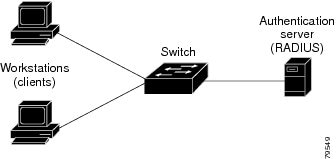
Host Detection
The switch maintains an IP device tracking table to store information about detected hosts.
Note: By default, the IP device tracking feature is disabled on a switch. You must enable the IP device tracking feature to use web-based authentication.
For Layer 2 interfaces, web-based authentication detects IP hosts by using these mechanisms:
■![]() ARP-based trigger—ARP redirect ACL allows web-based authentication to detect hosts with a static IP address or a dynamic IP address.
ARP-based trigger—ARP redirect ACL allows web-based authentication to detect hosts with a static IP address or a dynamic IP address.
■![]() DHCP snooping—Web-based authentication is notified when the switch creates a DHCP-binding entry for the host.
DHCP snooping—Web-based authentication is notified when the switch creates a DHCP-binding entry for the host.
Session Creation
When web-based authentication detects a new host, it creates a session as follows:
If the host IP is included in the exception list, the policy from the exception list entry is applied, and the session is established.
■![]() Reviews for authorization bypass.
Reviews for authorization bypass.
If the host IP is not on the exception list, web-based authentication sends a nonresponsive-host (NRH) request to the server.
If the server response is access accepted, authorization is bypassed for this host. The session is established.
■![]() Sets up the HTTP intercept ACL.
Sets up the HTTP intercept ACL.
If the server response to the NRH request is access rejected, the HTTP intercept ACL is activated, and the session waits for HTTP traffic from the host.
Authentication Process
When you enable web-based authentication, these events occur:
■![]() The user initiates an HTTP session.
The user initiates an HTTP session.
■![]() The HTTP traffic is intercepted, and authorization is initiated. The switch sends the login page to the user. The user enters a username and password, and the switch sends the entries to the authentication server.
The HTTP traffic is intercepted, and authorization is initiated. The switch sends the login page to the user. The user enters a username and password, and the switch sends the entries to the authentication server.
■![]() If the authentication succeeds, the switch downloads and activates the user’s access policy from the authentication server. The login success page is sent to the user.
If the authentication succeeds, the switch downloads and activates the user’s access policy from the authentication server. The login success page is sent to the user.
■![]() If the authentication fails, the switch sends the login fail page. The user retries the login. If the maximum number of attempts fails, the switch sends the login expired page, and the host is placed in a watch list. After the watch list times out, the user can retry the authentication process.
If the authentication fails, the switch sends the login fail page. The user retries the login. If the maximum number of attempts fails, the switch sends the login expired page, and the host is placed in a watch list. After the watch list times out, the user can retry the authentication process.
■![]() If the authentication server does not respond to the switch, and if an AAA fail policy is configured, the switch applies the failure access policy to the host. The login success page is sent to the user. (See Local Web Authentication Banner.)
If the authentication server does not respond to the switch, and if an AAA fail policy is configured, the switch applies the failure access policy to the host. The login success page is sent to the user. (See Local Web Authentication Banner.)
■![]() The switch reauthenticates a client when the host does not respond to an ARP probe on a Layer 2 interface, or when the host does not send any traffic within the idle timeout on a Layer 3 interface.
The switch reauthenticates a client when the host does not respond to an ARP probe on a Layer 2 interface, or when the host does not send any traffic within the idle timeout on a Layer 3 interface.
■![]() The feature applies the downloaded timeout or the locally configured session timeout.
The feature applies the downloaded timeout or the locally configured session timeout.
■![]() If the terminate action is RADIUS, the feature sends a nonresponsive host (NRH) request to the server. The terminate action is included in the response from the server.
If the terminate action is RADIUS, the feature sends a nonresponsive host (NRH) request to the server. The terminate action is included in the response from the server.
■![]() If the terminate action is default, the session is dismantled, and the applied policy is removed.
If the terminate action is default, the session is dismantled, and the applied policy is removed.
Local Web Authentication Banner
You can create a banner that will appear when you log in to a switch by using web authentication.
The banner appears on both the login page and the authentication-result pop-up pages:
You create a banner by using the ip admission auth-proxy-banner http global configuration command. The default banner Cisco Systems and Switch host-name Authentication appear on the Login Page. Cisco Systems appears on the authentication result pop-up page, as shown in Figure 25.
Figure 25 Authentication Successful Banner
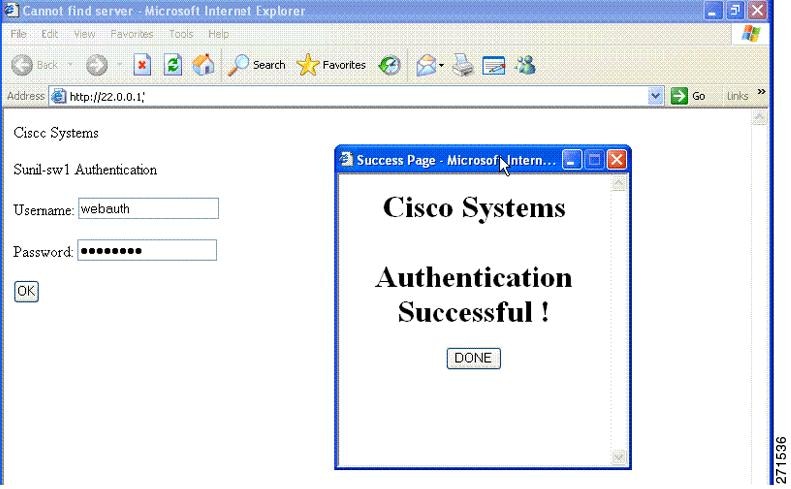
You can also customize the banner, as shown in Figure 26.
■![]() Add a switch, router, or company name to the banner by using the ip admission auth-proxy-banner http banner-text global configuration command.
Add a switch, router, or company name to the banner by using the ip admission auth-proxy-banner http banner-text global configuration command.
■![]() Add a logo or text file to the banner by using the ip admission auth-proxy-banner http file-path global configuration command.
Add a logo or text file to the banner by using the ip admission auth-proxy-banner http file-path global configuration command.
Figure 26 Customized Web Banner
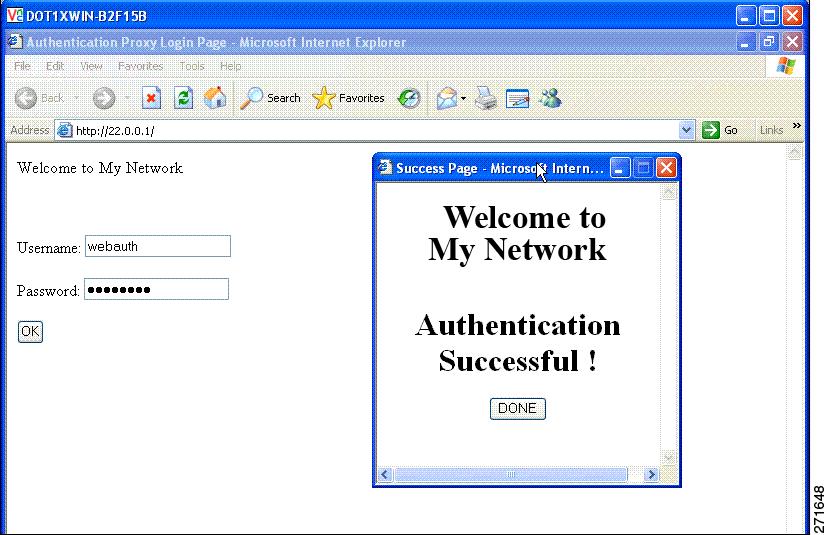
If you do not enable a banner, only the username and password dialog boxes appear in the web authentication login screen, and no banner appears when you log into the switch, as shown in Login Screen with No Banner.
Figure 27 Login Screen with No Banner
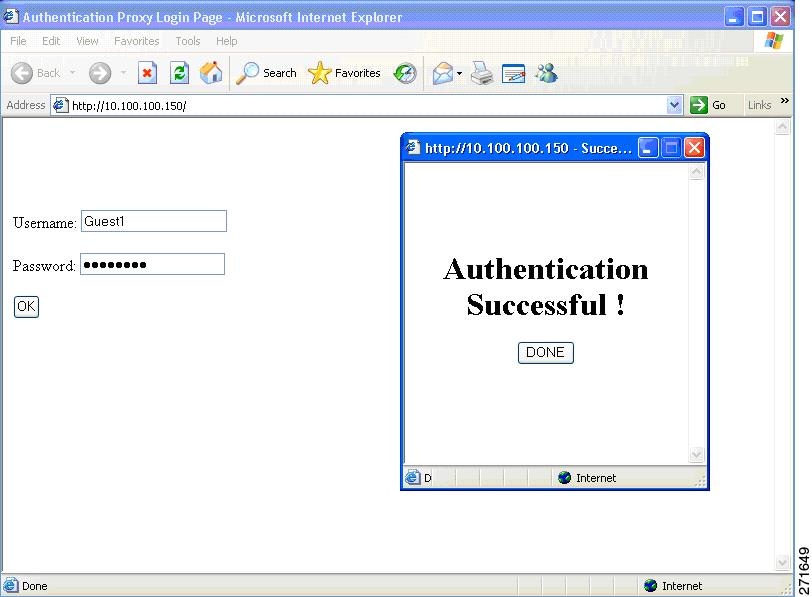
For more information, see the Cisco IOS Security Command Reference and Configuring a Web Authentication Local Banner.
Web Authentication Customizable Web Pages
During the web-based authentication process, the switch internal HTTP server hosts four HTML pages to deliver to an authenticating client. The server uses these pages to notify you of these four-authentication process states:
■![]() Login—Your credentials are requested.
Login—Your credentials are requested.
■![]() Success—The login was successful.
Success—The login was successful.
■![]() Expire—The login session has expired because of excessive login failures.
Expire—The login session has expired because of excessive login failures.
Web Authentication Guidelines
■![]() You can substitute your own HTML pages for the default internal HTML pages.
You can substitute your own HTML pages for the default internal HTML pages.
■![]() You can use a logo or specify text in the login, success, failure, and expire web pages.
You can use a logo or specify text in the login, success, failure, and expire web pages.
■![]() On the banner page, you can specify text in the login page.
On the banner page, you can specify text in the login page.
■![]() You must include an HTML redirect command in the success page to access a specific URL.
You must include an HTML redirect command in the success page to access a specific URL.
■![]() The URL string must be a valid URL (for example, http://www.cisco.com). An incomplete URL might cause page not found error or similar errors on a web browser.
The URL string must be a valid URL (for example, http://www.cisco.com). An incomplete URL might cause page not found error or similar errors on a web browser.
■![]() If you configure web pages for HTTP authentication, they must include the appropriate HTML commands (for example, to set the page time out, to set a hidden password, or to confirm that the same page is not submitted twice).
If you configure web pages for HTTP authentication, they must include the appropriate HTML commands (for example, to set the page time out, to set a hidden password, or to confirm that the same page is not submitted twice).
■![]() The CLI command to redirect users to a specific URL is not available when the configured login form is enabled. The administrator should ensure that the redirection is configured in the web page.
The CLI command to redirect users to a specific URL is not available when the configured login form is enabled. The administrator should ensure that the redirection is configured in the web page.
■![]() If the CLI command redirecting users to a specific URL after authentication occurs is entered and then the command configuring web pages is entered, the CLI command redirecting users to a specific URL does not take effect.
If the CLI command redirecting users to a specific URL after authentication occurs is entered and then the command configuring web pages is entered, the CLI command redirecting users to a specific URL does not take effect.
■![]() Configured web pages can be copied to the switch boot flash or flash.
Configured web pages can be copied to the switch boot flash or flash.
■![]() Configured pages can be accessed from the flash on the stack master or members.
Configured pages can be accessed from the flash on the stack master or members.
■![]() The login page can be on one flash, and the success and failure pages can be another flash (for example, the flash on the stack master or a member).
The login page can be on one flash, and the success and failure pages can be another flash (for example, the flash on the stack master or a member).
■![]() You must configure all four pages.
You must configure all four pages.
■![]() The banner page has no effect if it is configured with the web page.
The banner page has no effect if it is configured with the web page.
■![]() All of the logo files (image, flash, audio, video, and so on) that are stored in the system directory (for example, flash, disk0, or disk) and that must be displayed on the login page must use web_auth_filename as the filename.
All of the logo files (image, flash, audio, video, and so on) that are stored in the system directory (for example, flash, disk0, or disk) and that must be displayed on the login page must use web_auth_filename as the filename.
■![]() The configured authentication proxy feature supports both HTTP and SSL.
The configured authentication proxy feature supports both HTTP and SSL.
When configuring customized authentication proxy web pages, follow these guidelines:
■![]() To enable the custom web pages feature, specify all four custom HTML files. If you specify fewer than four files, the internal default HTML pages are used.
To enable the custom web pages feature, specify all four custom HTML files. If you specify fewer than four files, the internal default HTML pages are used.
■![]() The four custom HTML files must be present on the flash memory of the switch. The maximum size of each HTML file is 8 KB.
The four custom HTML files must be present on the flash memory of the switch. The maximum size of each HTML file is 8 KB.
■![]() Any images on the custom pages must be on an accessible HTTP server. Configure an intercept ACL within the admission rule.
Any images on the custom pages must be on an accessible HTTP server. Configure an intercept ACL within the admission rule.
■![]() Any external link from a custom page requires configuration of an intercept ACL within the admission rule.
Any external link from a custom page requires configuration of an intercept ACL within the admission rule.
■![]() To access a valid DNS server, any name resolution required for external links or images requires configuration of an intercept ACL within the admission rule.
To access a valid DNS server, any name resolution required for external links or images requires configuration of an intercept ACL within the admission rule.
■![]() If the custom web pages feature is enabled, a configured auth-proxy-banner is not used.
If the custom web pages feature is enabled, a configured auth-proxy-banner is not used.
■![]() If the custom web pages feature is enabled, the redirection URL for successful login feature is not available.
If the custom web pages feature is enabled, the redirection URL for successful login feature is not available.
■![]() To remove the specification of a custom file, use the no form of the command.
To remove the specification of a custom file, use the no form of the command.
Because the custom login page is a public web form, consider these guidelines for the page:
■![]() The login form must accept user entries for the username and password and must show them as uname and pwd.
The login form must accept user entries for the username and password and must show them as uname and pwd.
■![]() The custom login page should follow best practices for a web form, such as page timeout, hidden password, and prevention of redundant submissions.
The custom login page should follow best practices for a web form, such as page timeout, hidden password, and prevention of redundant submissions.
You can substitute your HTML pages, as shown in Customizeable Authentication Page, for the default internal HTML pages. You can also specify a URL to which users are redirected after authentication occurs, which replaces the internal Success page.
Figure 28 Customizeable Authentication Page
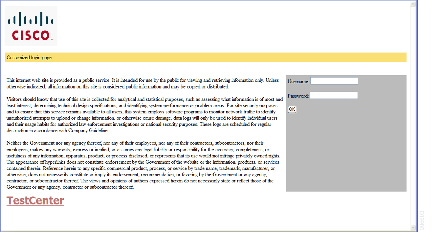
Web-Based Authentication Interactions with Other Features
■![]() ACLs
ACLs
Port Security
You can configure web-based authentication and port security on the same port. Web-based authentication authenticates the port, and port security manages network access for all MAC addresses, including that of the client. You can then limit the number or group of clients that can access the network through the port.
LAN Port IP
You can configure LAN port IP (LPIP) and Layer 2 web-based authentication on the same port. The host is authenticated by using web-based authentication first, followed by LPIP posture validation. The LPIP host policy overrides the web-based authentication host policy.
If the web-based authentication idle timer expires, the NAC policy is removed. The host is authenticated, and posture is validated again.
Gateway IP
You cannot configure Gateway IP (GWIP) on a Layer 3 VLAN interface if web-based authentication is configured on any of the switch ports in the VLAN.
You can configure web-based authentication on the same Layer 3 interface as Gateway IP. The host policies for both features are applied in software. The GWIP policy overrides the web-based authentication host policy.
ACLs
If you configure a VLAN ACL or a Cisco IOS ACL on an interface, the ACL is applied to the host traffic only after the web-based authentication host policy is applied.
For Layer 2 web-based authentication, you must configure a port ACL (PACL) as the default access policy for ingress traffic from hosts connected to the port. After authentication, the web-based authentication host policy overrides the PACL.
Note: When a proxy ACL is configured for a web-based authentication client, the proxy ACL is downloaded and applied as part of the authorization process. Hence, the PACL displays the proxy ACL access control entry (ACE).
You cannot configure a MAC ACL and web-based authentication on the same interface.
You cannot configure web-based authentication on a port whose access VLAN is configured for VACL capture.
Context-Based Access Control
Web-based authentication cannot be configured on a Layer 2 port if context-based access control (CBAC) is configured on the Layer 3 VLAN interface of the port VLAN.
802.1x Authentication
You cannot configure web-based authentication on the same port as 802.1x authentication except as a fallback authentication method.
EtherChannel
You can configure web-based authentication on a Layer 2 EtherChannel interface. The web-based authentication configuration applies to all member channels.
Default Web-Based Authentication Settings
|
|
|
|---|---|
Configuring Switch-to-RADIUS-Server Communication
RADIUS security servers identification:
■![]() Host name and specific UDP port numbers
Host name and specific UDP port numbers
■![]() IP address and specific UDP port numbers
IP address and specific UDP port numbers
The combination of the IP address and UDP port number creates a unique identifier, that enables RADIUS requests to be sent to multiple UDP ports on a server at the same IP address. If two different host entries on the same RADIUS server are configured for the same service (for example, authentication) the second host entry that is configured functions as the failover backup to the first one. The RADIUS host entries are chosen in the order that they were configured.
How to Configure Web-Based Authentication
Configuring the Authentication Rule and Interfaces
Configuring AAA Authentication
Configuring Switch-to-RADIUS-Server Communication
Configuring the HTTP Server
|
|
|
|
|---|---|---|
| Enables the HTTP server. The web-based authentication feature uses the HTTP server to communicate with the hosts for user authentication. |
||
Customizing the Authentication Proxy Web Pages
You can configure web authentication to display four substitute HTML pages to the user in place of the switch default HTML pages during web-based authentication.
To specify the use of your custom authentication proxy web pages, first store your custom HTML files on the switch flash memory, then perform this task in global configuration mode:
Specifying a Redirection URL for Successful Login
You can specify a URL to which the user is redirected after authentication, effectively replacing the internal Success HTML page.
|
|
|
|
|---|---|---|
Specifies a URL for redirection of the user in place of the default login success page. |
Configuring the Web-Based Authentication Parameters
You can configure the maximum number of failed login attempts before the client is placed in a watch list for a waiting period.
|
|
|
|
|---|---|---|
Sets the maximum number of failed login attempts. The range is 1 to 2147483647 attempts. The default is 5. |
||
Configuring a Web Authentication Local Banner
Removing Web-Based Authentication Cache Entries
Enter a specific IP address to delete the entry for a single host. Use an asterisk to delete all cache entries.
|
|
|
|---|---|
Monitoring and Maintaining Web-Based Authentication
|
|
|
|---|---|
Configuration Examples for Configuring Web-Based Authentication
Enabling and Displaying Web-Based Authentication: Examples
This example shows how to verify the configuration:
Enabling AAA: Example
This example shows how to enable AAA:
Configuring the RADIUS Server Parameters: Example
This example shows how to configure the RADIUS server parameters on a switch:
Configuring a Custom Authentication Proxy Web Page: Example
This example shows how to configure custom authentication proxy web pages:
Verifying a Custom Authentication Proxy Web Page: Example
This example shows how to verify the configuration of a custom authentication proxy web pages:
Configuring a Redirection URL: Example
This example shows how to configure a redirection URL for successful login:
Verifying a Redirection URL: Example
This example shows how to verify the redirection URL for successful login:
Configuring a Local Banner: Example
This example shows how to configure a local banner with the custom message My Switch:
Clearing the Web-Based Authentication Session: Example
This example shows how to remove the web-based authentication session for the client at the IP address 209.165.201.1:
Additional References
The following sections provide references related to switch administration:
Related Documents
|
|
|
|---|---|
Authentication proxy configuration |
Standards
|
|
|
|---|---|
No new or modified standards are supported by this feature, and support for existing standards has not been modified by this feature. |
MIBs
|
|
|
|---|---|
To locate and download MIBs using Cisco IOS XR software, use the Cisco MIB Locator found at the following URL and choose a platform under the Cisco Access Products menu: http://cisco.com/public/sw-center/netmgmt/cmtk/mibs.shtml |
RFCs
|
|
|
|---|---|
No new or modified RFCs are supported by this feature, and support for existing RFCs has not been modified by this feature. |
 Feedback
Feedback